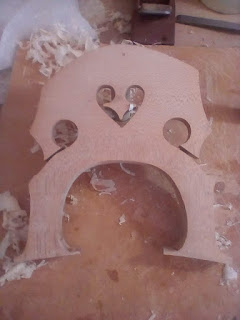Double Bass - Repair

 The half-sized student bass arrived suffering from an earlier repair. The neck had been repaired - with screws - and reset, but the angle had been too flat for the bridge. Worse, with the fingerboard in place the action of the strings was too high for the bass to be playable. The bridge had been lowered by taking wood off the feet, to the point where new wafers had been glued on to reinstate the feet profile.
The half-sized student bass arrived suffering from an earlier repair. The neck had been repaired - with screws - and reset, but the angle had been too flat for the bridge. Worse, with the fingerboard in place the action of the strings was too high for the bass to be playable. The bridge had been lowered by taking wood off the feet, to the point where new wafers had been glued on to reinstate the feet profile. The repair involved three main elements - the neck, the nut and the bridge.
The neck was planed flat, removing the bow. This had the effect of removing four mm from the height of the heel. The two small screws were removed before planing, and their countersinks redrilled before their reinstatement.
 A piece of recycled Rimu (tongue-groove flooring!) was cut and shaped to form a wedge, which was then glued onto the neck, taking care to cut a rebate to keep the screw heads exposed.
A piece of recycled Rimu (tongue-groove flooring!) was cut and shaped to form a wedge, which was then glued onto the neck, taking care to cut a rebate to keep the screw heads exposed.
I then glued a strip of maple to the base of the nut, raising it to counter the slight elevation of the fingerboard. The fingerboard end was then shaved to counter the new angle, and the fingerboard reinstated.
The bridge was the final part.
 Each of the feet had ben shaved so high that the feet were grafted slivers of maple. Owing to the new angle of the fingerboard, the bridge was now 15 mm too low.
Each of the feet had ben shaved so high that the feet were grafted slivers of maple. Owing to the new angle of the fingerboard, the bridge was now 15 mm too low.

 The blocks were then sawn to shape the legs and feet of the bridge.
The blocks were then sawn to shape the legs and feet of the bridge.With final finishing and feet shaping, the bridge was fitted and the bass restrung.





No comments:
Post a Comment